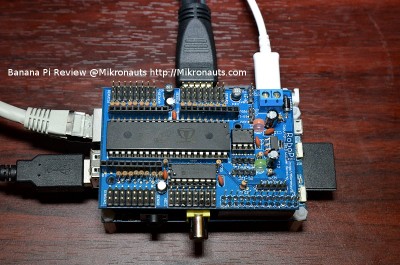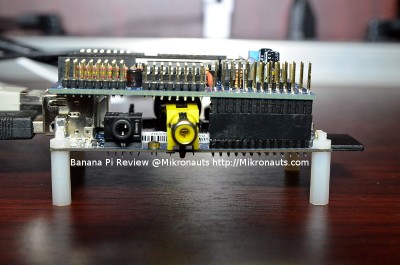Banana Pi Review
WiringPi test:
#include <wiringPi.h>
#include <stdio.h>
int main(int argc, char **argv) {
int i;
if (wiringPiSetup()==-1)
exit(1);
wiringPiSetupGpio();
for(i=22;i<26;i++)
pinMode(i, OUTPUT);
while(1) {
for(i=22;i<26;i++) {
digitalWrite(i,1);
delay(1000);
}
for(i=22;i<26;i++) {
digitalWrite(i,0);
delay(1000);
}
}
}
I compiled and executed it with:
gcc -o test test.c -l wiringPi
sudo ./test
Python test:
$ sudo python
Python 2.7.3 (default, Mar 18 2014, 05:13:23)
[GCC 4.6.3] on linux2
Type “help”, “copyright”, “credits” or “license” for more information.
>>> import RPi.GPIO as io
BAPI: Banana Pi!!
BAPI: Banana Pi!!
BAPI: Banana Pi!!
BAPI: Banana Pi!!
BAPI: revision(3)
>>> io.setmode(io.BCM)
>>> io.setup(22,io.OUT)
>>> io.output(22,1)
>>> io.output(22,0)
>>>
GPIO utility from the command line:
What can I say? It just worked.
“gpio -h” gets you some basic help
“gpio readall” shows you the current state of every pin, along with the WiringPi, Broadcom and physical I/O number
“gpio write 3” for example writes to Broadcom pin 22
Dare I say it?
Easy as Pie!
4) Multimedia
Driver support for the video capabilities of the A20 is being worked on, so hopefully before long we will have great MPEG2 and H.264 decoding.
The Allwinner A20 is actually capable of playing back 4K files, so it should only be a matter of time before there is good multimedia support.
Of course, the Raspberry Pi already has excellent multimedia support right now, so if your usage involves playing 1080p video, the Raspberry Pi is a better choice for you.
5) Wolfram / Mathematica
The Banana Pi is not licensed for the free Wolfram language and Mathematica like the Raspberry Pi, so I would recommend that those packages be removed from Raspbian for the Banana Pi. The software requires a key, one that will not be supplied for the Banana Pi, so it is just a waste of space to include them (unless, of course, Lemaker manages to negotiate a license for the software).
Hardware Compatibility
One of the chief complaints that I anticipate about the Banana Pi is that it is not 100% hardware compatible.
It uses a different SOC (System On a Chip). It CANNOT be 100% hardware compatible.
The mounting holes are in a different place as well – which in my opinion is not significant, as there were no mounting holes before rev.2 of the Raspberry Pi, and the new Model B+ has moved them again.
The board seating differently, due to the shifting of the GPIO connector is a problem shared with the new Raspberry Pi Model B+ (see https://www.mikronauts.com/raspberry-pi/bplus-review/)
I thought I’d see how my products, which were designed for the Raspberry Pi, fit on and work with the Banana Pi… as that would give an indication on how other third party Raspberry Pi add-ons may work with the Banana Pi.
RoboPi
I have not qualified RoboPi on the Banana Pi. Here I am just checking to see if it will physically fit, and power up. I will update this review as soon as I have the RoboPi libraries qualified for the Banana Pi.
It fit quite well, however I’d recommend putting some electrical tape on top of the Ethernet and USB jacks.
(click on image for larger version)
And from the side:
(click on image for larger version)
Oops. I should have pressed down a bit more on the side with the USB / Ethernet jacks.
Review Index
Page 1: Introduction, Does it look the same?
Page 2: Closer Look, Feature Comparison
Page 3: Operating Systems, Software Compatibility
Page 4: WiringPi, RPi.GPIO, Hardware Compatibility
Page 5: More board compatibility test results
Page 6: USB WiFi stick Compatibility, Documentation, Benchmarks
Page 7: Power Utilization, Support, Conclusion

